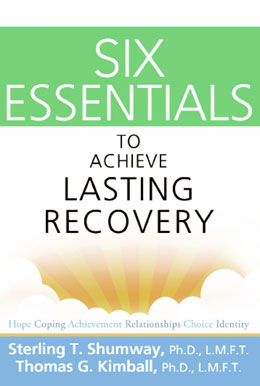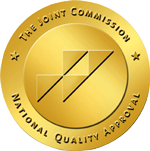
"Hope can only burn bright if you are not constantly subjecting yourself to the pain of past relationships and to the loud call of those who don't want you to change."

Other titles you may like.

Mindfulness and the 12 Steps:
Living Recovery in the Present Moment

The Spiritual Self:
Reflections on Recovery and God

The Recovering Body: Physical and Spiritual
Fitness for Living Clean and Sober
Visit Recovery Road to view and
listen to all the episodes.
Episode 136 -- August 2, 2021
Hope Grows in the Recovery Greenhouse
Sometimes the scariest thing in early recovery is letting go of what we know. Once we see what we need to let go of in ourselves, we start to look around us and see what else—and who else—needs to go.
In their book Six Essentials to Achieve Lasting Recovery, Dr. Sterling Shumway and Dr. Thomas Kimball identify six principles that reinforce the Twelve Steps. They offer them as keys to maintaining lasting recovery.
The following excerpt compares recovery to a greenhouse. We learn how hope can be the water and nutrients we need to keep ourselves, our recovery, and our healthy relationships flourishing. People can be as addictive as substances. Some of these people will be easy to spot, but some are more difficult to identify and it may take a little longer to realize they are stifling our hope. This excerpt offers help in sorting through our relationships to figure out which ones feed us and which hinder our growth. For the longest time there was no greenhouse or hope, but in recovery we can begin anew—with the right gardening tools.
This excerpt has been edited for brevity.
We define hope as "a reawakening after despair" and "to expect with greater confidence." The spiral of addiction creates despair. When you hit bottom and realize there is no hope without change—only more destruction and ultimately death—a reawakening occurs. Hitting bottom is often called a moment of clarity, a moment of grace, or a moment of hope. It is a moment of clarity when you grasp that the pain and despair of addiction exceed any benefit of using. Hope emerges when you become aware that living is an option. For those of you who have fallen off the edge and have found the cold, hard bottom of addiction—short of dying—you realize there is nowhere to go but up.
This bottom is the beginning of a new set of expectations, the most important of which is the realization that failure and ultimately death (emotional, spiritual, psychological, and physical) doesn't have to be your destiny. This fall provides the initial springboard to a renewal of hope and to a greater faith.
This is where you begin to understand not just "who you are" (a moment of clarity) but "who you can become" (a lifetime of clarity). In contrast to the pain and despair of addiction, this hope—within a spiritual context—is transformative. It allows you to find your identity, develop meaningful relationships, achieve and accomplish, cope in more effective ways, and reclaim your agency by making better choices.
Hope is contagious and begins to permeate all of your social and personal interactions. One of the negative by-products of addiction is the trail of "dead" relationships that are left behind. Some of these associations may need to remain in the "dead" category for your success in recovery. However, hope tells us that there are relationships that can and should be revived. As is the case in a flower garden, many plants and flowers go dormant during the cold winter months. Some plants appear to be dead and others exist only below the garden's surface—deep within the soil. With the advent of greater sunlight and warmth, water, and nutrients, these plants and flowers are revitalized and spring forth into a beautiful chorus of colors. Like sun to the flower, hope offers warmth and light to the soul and to the souls around us. The person in recovery who attends to the soil and spends time in the recovery garden nurturing these relationships can expect good things, such as the blossoming of meaningful relationships.
Hope also provides the water and nutrients to resurrect relationships thought to be dead and to cause other critical relationships to spring forth and grow into recovery support systems. Like many relationships bruised by addiction, some bulbs and flowers lie dormant. After proper care, sunlight, and nutrients (akin to taking care of your own recovery, making amends, and staying clean/sober), these dormant relationships may emerge and blossom. Just as we cannot make flowers grow without the flowers' cooperation, these relationships cannot be forced, only fostered and encouraged. Some relationships will not respond to the care and will need to be allowed to lie dormant.
With hope in your heart, you will stay in the present—not beating yourself up for the relationship wreckage of the past. We often inflict unnecessary pain on ourselves when we dwell only on our mistakes, immersing ourselves in the anxiety of previous failures or attempting to obsessively control our futures. These anxieties and attempts at control go contrary to the one-day-at-a-time perspective so important to healthy recovery. As a guide in our relationships, hope mentors patience and acceptance of how things are, not how we want them to be. Within this new space, bruised relationships are rebuilt and begin to grow and flourish. Other relationships should be discarded if they cannot coexist within a recovery context.
Recovery is a greenhouse of sorts. What grows within it should be nurtured and cared for, and what doesn't should be allowed to die.
Perhaps most difficult for any gardener are flowers that have died and will never emerge again. Particularly early in recovery, some relationships must be severed. Other relationships will slowly die if given unrealistic expectations and demands. Change creates dissonance in relationships, especially when others are not in sync with these changes. Addiction has the potential to kill even the strongest friendships and familial ties—the trauma, abuse, and neglect caused by addiction extract a terrible toll. The lies, infidelity, financial ruin, manipulation, and control are all part of the addiction spiral and are never victimless.
Hope can only burn bright if you are not constantly subjecting yourself to the pain of past relationships and to the loud call of those who don't want you to change. Those persons you love who are not in recovery may say things such as, "You're not really an addict—just come and be with us," or "You don't have to use—just one more for old times' sake." Further still, old friends may say, "You can't make it without us; we are the only friends you have." The thought of these dead relationships can be devastatingly overwhelming, but remember that acceptance of these dead relationships is part of good recovery. In the beginning, you may find yourself standing with your Higher Power as your only friend, but know that this is enough in the critical moments of early recovery and will change over time.
About the Author:
Thomas G. Kimball, PhD, LMFT, is an associate professor at Texas Tech University and the associate managing director for the Center for the Study of Addiction and Recovery. He teaches family dynamics of addiction at both the undergraduate and the graduate levels. In addition, he is the clinical director of the outpatient program and co-facilitates multi-family groups at The Ranch at Dove Tree— an inpatient alcohol and drug treatment program.
Sterling T. Shumway, PhD, LMFT, is a regents' professor in the Department of Applied and Professional Studies, Addictive Disorders and Recovery Studies Division (ADRS) at Texas Tech University. He currently serves as the program director of the Addiction and Recovery Studies Program. In addition, he has a private therapy practice where he sees individuals, couples, and families and also co-facilitates multi-family groups as the family program director at The Ranch at Dove Tree.
© 2012 by Hazelden
All rights reserved

